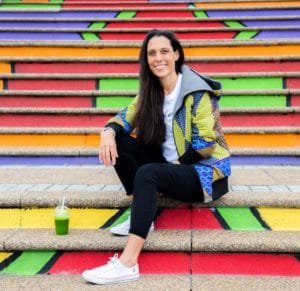Leading the Change

Because it’s Women’s Month, we sat down with GREEN HOME’s very own founder and MD Catherine Morris (known to most as Cat) for a chat about SA’s biodegradable revolution, women and what keeps her inspired.
It’s been 11 years since you started GREEN HOME. Looking back, do any key inspirations stand out from the journey so far?
My main inspiration has been our clients. In order to do what we set out to do, everyone needs to come to the party.
The Ethical co-op were our very first client, invoice number 0001. They, and others like them, were waiting for products like these. But many, many other clients have been ready and willing to come on board, ready to be change agents. That willingness and passion inspires me. It’s a partnership -we can only make a difference in collaboration with our clients.
Our clients are doing a lot of cool things, and we get to help them do it. The food space is an exciting space to work in.
Your vision is to make plant-based packaging the norm. Is this something that developed, or was it your starting goal?
It’s been a steady goal right from the beginning.
As well as challenging the norm in packaging, when we started the company, we also wanted it to be women owned and women led. To challenge the norm there too. We need female input. It’s important for women to contribute more in running businesses and in leadership roles. Women have a huge role to play in building a more sustainable and equitable South Africa.
You started GREEN HOME after seeing a tapioca starch cup while on holiday in Thailand. Had you previously considered getting into packaging?
Not at all. I imagined myself in a green or humanitarian space. When I was younger I thought I’d work for Greenpeace or Oxfam.
So that tapioca starch cup must have made quite an impression?
Coming from an environmental background – I was head of Earth Life Africa at UCT – I was aware of the environmental harm being caused by packaging, along with many other environmental issues.
When I saw the cup it felt like an important piece of the puzzle. It made sense. When something really makes sense it gives you a physical sense of being in alignment. It had that effect on me.
So how far have we come? What’s your progress report for biodegradable packaging over the last 11 years in SA?
It’s massive. In terms of market readiness – there’s been a complete turn around. From being marginal and alternative, we’re now much more central.
In the beginning, the terms ‘biodegradable’ and ‘compostable’ were completely unfamiliar and not understood, we always had to qualify them. Now these terms are being widely used and are seen on a range of products, such as cleaning products etc.
There has been a huge and sudden awakening in the public and in the market. In the beginning, I had to present the case for the need for change and educate people about plastic pollution. Now the media does this. The news is in the public domain. And many businesses are banning plastic straws and bags and choosing biodegradable products, and large supermarkets are making moves away from single-use plastics.
So, aside from packaging, do you have any other recent achievements you’re proud of?
I ran 30kms on Table Mountain a month ago!
And I’m really proud of the hemp house we built in Khayelitsha for Yiza Ekhaya. It was such an amazing project. A real collaboration of goodwill.
And lastly, what gets you out of bed in the morning?
Yoga. And good coffee. In that order. Which gets me geared up for working on what I love.
Want to hear more? Have a listen to Cat’s chat with Pippa Hudson on Cape Talk. (Recorded 10/08/2018)
